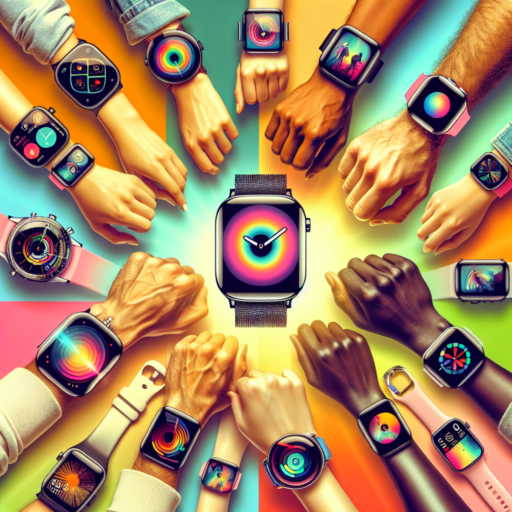Introduction to Smartwatch Types
Exploring the World of Smartwatches
In today’s fast-paced digital era, smartwatches have transformed from being a novel gadget to an indispensable accessory. These wearable devices offer a blend of functionality and style, catering to a wide spectrum of needs and preferences. With the evolution of technology, smartwatches have diversified, leading to the emergence of various types that serve different purposes, from health tracking to seamless connectivity.
The Primary Categories of Smartwatches
At their core, smartwatches can be broadly categorized into three primary types: Companion smartwatches, Standalone smartwatches, and Fitness-focused smartwatches. Companion smartwatches are designed to work alongside your smartphone, displaying notifications and allowing you to manage calls and messages. Standalone smartwatches, on the other hand, function independently with their own cellular connectivity, freeing you from carrying your phone. Lastly, Fitness-focused smartwatches emphasize health and activity tracking, equipped with sensors to monitor various physical metrics.
Choosing the Right Smartwatch
Selecting the appropriate smartwatch depends on understanding your needs. Whether it’s for staying connected without needing to access your smartphone, maintaining an active and healthy lifestyle, or simply enjoying the latest in wearable technology, there’s a smartwatch type that fits every requirement. Knowing the capabilities and limitations of each category can guide you in making an informed decision and ensuring that you get the most out of this innovative device.
The Evolution of Smartwatches: From Fitness Trackers to High-Tech Wearables
The journey of smartwatches has been nothing short of revolutionary. Their transformation from simple fitness trackers to today’s high-tech wearables highlights not just a leap in technology but in how we interact with our gadgets on a daily basis. Initially, smartwatches carved their niche by offering fitness enthusiasts a way to monitor basic health metrics like steps taken, calories burned, and heart rate. However, this was only the beginning of what would become a multi-functional device essential for both tech enthusiasts and the everyday person.
As technology advanced, so did the capabilities of these wrist-worn companions. Smartwatches began to incorporate features far beyond health monitoring. The integration of notifications for calls, messages, and even app alerts brought a new level of convenience, blurring the lines between smartphones and wearables. Manufacturers also started focusing on the design aspect, making these gadgets not only functional but fashionable accessories that could be customized to fit the wearer’s style and preferences.
Today, the evolution of smartwatches represents a blend of technology and lifestyle. With capabilities like contactless payments, GPS navigation, and even cellular connectivity, smartwatches are no longer just an accessory but a necessity for many. The development of voice-activated assistants and compatibility with a wide range of applications has transformed these devices into standalone gadgets that offer an array of services right from your wrist.
Comparing the Different Types of Smartwatches
In the evolving landscape of wearable technology, smartwatches have become indispensable accessories for many. They seamlessly integrate functionality and fashion, making them a popular choice among tech enthusiasts and casual users alike. However, with a plethora of options available, choosing the right smartwatch can be daunting. This article delves into the various types of smartwatches, helping you navigate through your options.
Fitness Trackers vs. Smartwatches
Initially, smartwatches were an extension of a smartphone, offering notifications and basic app functionality on your wrist. However, the distinction between fitness trackers and full-fledged smartwatches has blurred over time. Fitness trackers, like the Fitbit Charge, are primarily focused on health and activity monitoring, offering detailed insights into your workouts, steps, and sleep. On the back end, these devices tend to have a longer battery life due to their focused functionality. In contrast, smartwatches like the Apple Watch or Samsung Galaxy Watch encapsulate a broader range of features, including but not limited to fitness tracking. They run more complex operating systems, support third-party apps, and often include features like mobile payments and LTE connectivity.
Hybrid Smartwatches
For those who appreciate the traditional watch aesthetic but crave the smart features, hybrid smartwatches strike a perfect balance. These devices look like conventional watches but include smart functionalities such as step tracking, sleep monitoring, and smartphone notifications. The Fossil Hybrid HR is a prime example, offering a classic design with an e-ink display beneath the watch hands. Hybrids are the underdogs of the smartwatch world, often boasting extended battery life due to their minimalistic smart functions and mechanical design elements.
Navigating through the spectrum of smartwatches, it’s clear that the choice heavily depends on personal preference and intended use. Whether you lean towards fitness tracking, extensive smart capabilities, or a blend of traditional and tech, there’s a smartwatch configured to match every lifestyle. Understanding the core features and limitations of each type can guide consumers in making informed decisions that align with their needs and preferences.
Fitness and Health Tracking Smartwatches
The revolution of Fitness and Health Tracking Smartwatches has transformed how individuals monitor their daily activities, health parameters, and set fitness goals. These wearables are not just time-keeping gadgets but comprehensive fitness companions designed to cater to the diverse needs of fitness enthusiasts and health-conscious individuals.
At the core of their functionality, these smartwatches offer real-time tracking of vital health metrics such as heart rate, sleep quality, and blood oxygen levels. With advanced sensors and algorithms, they provide insights that can motivate users to maintain a healthy lifestyle and potentially detect early signs of certain health conditions. The convenience of having all these features on your wrist encourages constant awareness and proactive health management.
Integration with Mobile Health Apps is a crucial feature of today’s fitness and health tracking smartwatches. This compatibility enhances the user experience by allowing data synchronization, which enables a comprehensive view of health and fitness data over time. Users can track their progress, set personal goals, and even receive customized workout and health recommendations, all through the interface of their smartphones.
In summary, the impact of Fitness and Health Tracking Smartwatches on personal health management is profound. They have become essential tools for anyone looking to improve their physical condition, monitor health parameters, or simply lead a more active lifestyle. As technology advances, these devices will undoubtedly continue to play a significant role in the global fitness and health landscape.
Luxury and Designer Smartwatch Models
In the world of wearable technology, the luxury and designer smartwatch models stand out for their exceptional blend of technology and high-fashion aesthetics. These high-end wearables are not just about keeping you connected; they embody sophistication, featuring premium materials, innovative design, and craftsmanship that appeals to those with a taste for the finer things in life. As we delve into this sumptuous category, we uncover the hallmark traits that distinguish these opulent gadgets from their more utilitarian counterparts.
Exclusive Materials and Craftsmanship
One defining characteristic of luxury and designer smartwatches is the use of exclusive materials. Whether it’s a case crafted from 18-karat gold, a dial encrusted with diamonds, or straps made from high-quality leather or exotic skins, these materials contribute to both the aesthetic appeal and the value of the smartwatch. Coupled with meticulous craftsmanship that often involves hand-finishing, these watches are as much a fashion statement as they are technological marvels.
Advanced Features and Personalization
Beyond their stunning exteriors, luxury smartwatches are equipped with advanced features that enhance connectivity, health monitoring, and personal productivity. From bespoke watch faces to on-demand concierge services, these watches offer a range of personalization options and exclusive services tailored to the discerning user’s preferences. This fusion of technology and personal touch elevates the smartwatch from a mere gadget to an integral part of the user’s lifestyle and personal identity.
Kid-Friendly Smartwatches: Features and Parental Controls
Smartwatches designed for kids have transformed the way parents and children interact with technology today. These devices come loaded with features specifically tailored to offer both fun and safety for the younger users. With advancements in technology, kid-friendly smartwatches now include a range of capabilities that cater to the needs and concerns of both parents and their children.
Essential Features of Kid-Friendly Smartwatches
Kid-friendly smartwatches go beyond the basic time-telling functionality. They are equipped with GPS tracking, allowing parents to monitor their child’s location in real-time. This can be incredibly reassuring for parents wanting to ensure their child’s safety while they explore the world outside. Moreover, these watches often feature geofencing capabilities, enabling parents to set safe zones and receive alerts if their kid ventures outside these areas. Additionally, children can enjoy features like cameras for taking photos, voice messaging, and even educational games that make learning fun.
Implementing Parental Controls
Parental controls are at the heart of kid-friendly smartwatches, offering parents peace of mind. Through a dedicated app, parents can customize the functionalities of the watch, limiting or allowing access to various features depending on their child’s age and maturity. For instance, they can control the contact list, ensuring kids can only communicate with pre-approved contacts. Furthermore, parents can manage screen time to discourage excessive use and promote healthy digital habits. With these controls, smartwatches can provide a safe, controlled introduction to digital technology for kids.
The Rise of Hybrid Smartwatches: Analogue Aesthetics with Smart Features
The hybrid smartwatch sector is an intriguing evolution in wearable technology, merging the classical elegance of analogue watches with the innovative features of smart technology. These timepieces offer a sophisticated aesthetic that belies their technological prowess, presenting a blend of tradition and modernity that appeals to both fashion enthusiasts and tech aficionados alike. This unique combination has led to a rise in popularity, as consumers look for devices that complement their style without sacrificing functionality.
At the core of hybrid smartwatches is their ability to combine notification alerts, activity tracking, and even sleep monitoring with the timeless look of an analogue watch. Unlike their fully digital counterparts, these watches maintain a traditional watch face, often enhanced with subtle digital displays or indicators. This design philosophy allows users to enjoy the best of both worlds – the classic appeal of an analogue watch with the convenience and utility of modern smart features. The appeal is clear: a watch that maintains the aesthetics of traditional craftsmanship while embracing the benefits of contemporary technology.
Furthermore, the rise of hybrid smartwatches has been facilitated by advancements in battery life and connectivity. Where traditional smartwatches require daily charging, hybrids can last weeks, or even months, on a single charge, drastically reducing the hassle of constant power management. This endurance is matched by seamless connectivity to smartphones, enabling users to track their fitness, receive notifications, and even control music playback without compromising on style. The hybrid smartwatch represents a significant innovation in wearable technology, offering a compromise between the beauty of mechanical watches and the functionality of smart devices.
No se han encontrado productos.
Operating Systems in Smartwatches: Android Wear vs. watchOS vs. Others
In the dynamic realm of wearable technology, smartwatches have become indispensable for many, acting as an extension of our smartphones and, in some cases, as stand-alone mini computers on our wrists. At the heart of these sophisticated gadgets are their operating systems (OS), which define the user experience, functionality, and compatibility of the device. Android Wear (now known as Wear OS by Google) and watchOS (by Apple) are the most renowned players in this space, but there are other contenders that add variety and cater to specific needs.
Key Features of Android Wear and watchOS
Android Wear, rebranded as Wear OS, offers a versatile platform that supports a wide range of apps and faces, making it highly customizable. It’s known for its seamless integration with both Android and iOS devices, although it provides a richer experience with Android smartphones. Google Assistant on Wear OS is a game-changer for many, offering voice-controlled functionalities. On the other hand, watchOS, powering Apple Watch, stands out for its fluid interface and the ecosystem within which it operates. Its seamless integration with iOS devices, health and fitness tracking capabilities, and superior build quality make it a preferred choice for iPhone users.
Exploring Other Smartwatch Operating Systems
Beyond these giants, there are other notable operating systems like Samsung’s Tizen and Garmin’s proprietary software. Tizen, used in Samsung Galaxy smartwatches, offers smooth performance, impressive battery life, and excellent integration with Samsung’s ecosystem. Garmin’s watches, targeted at fitness enthusiasts, boast a robust build, superior battery life, and specialized health tracking features. These operating systems provide viable alternatives to users who prioritize specific features over mainstream popularity.
Each OS brings something unique to the table, influencing the decision-making process for consumers. Whether it’s the variety and customization offered by Wear OS, the sleek performance and health-centric features of watchYangOS, or the specific advantages of systems like Tizen and Garmin, the choice ultimately depends on personal preferences, the primary use case, and the ecosystem one is already invested in.
Key Features to Look for in a Smartwatch
When shopping for a smartwatch, it becomes imperative to know the key features that set the best models apart from the multitude of options available. Understanding these essential characteristics can greatly enhance your user experience, ensuring that your smartwatch serves not just as a timepiece, but as a versatile tool to compliment your lifestyle.
Compatibility with Your Smartphone
One of the first aspects to consider is how well the smartwatch integrates with your existing smartphone. A seamless connection between your smartwatch and smartphone allows for a cohesive experience, enabling features such as message notifications, call handling, and app synchronization. This compatibility ensures your smartwatch acts as an extension of your phone, providing convenience and efficiency.
Health Monitoring Capabilities
Another critical component is the range of health monitoring features available. Modern smartwatches offer a variety of sensors and tools to track your physical activities, including heart rate monitors, sleep analysis, and steps counting. These features not only support your fitness goals but also provide valuable insights into your overall health and well-being.
Battery Life and Connectivity Options
Finally, considering the battery life and connectivity options of a smartwatch is vital. A long-lasting battery ensures your watch keeps running for days without the need for frequent charging, while multiple connectivity options, such as Bluetooth, Wi-Fi, and NFC, enhance its utility by facilitating payments, music streaming, and data sharing. These features collectively augment the smartwatch experience, making it more convenient and multifaceted.
Choosing the Right Smartwatch Type for Your Needs
When it comes to selecting the perfect smartwatch, understanding the different types available is crucial. The decision should align with your lifestyle, needs, and preferences. From fitness enthusiasts to tech aficionados, there’s a smartwatch type designed to cater to every user’s requirements.
Fitness Trackers vs. Smartwatches
At a glance, fitness trackers and smartwatches might seem similar, but they serve different purposes. Fitness trackers, as the name suggests, are primarily focused on health and activity monitoring. They come equipped with features such as step counting, heart rate monitoring, and sleep tracking. On the other hand, smartwatches offer a broader range of functionalities, including but not limited to fitness tracking. They enable text and call notifications, app support, and sometimes even mobile payments, making them a more versatile choice for those looking for an all-in-one device.
Hybrid Smartwatches
For those who appreciate the classic look of analog watches but desire the connectivity features of a smartwatch, hybrid smartwatches are the ideal choice. These devices blend the traditional watch aesthetic with smart functionalities like activity tracking and smartphone notifications. They often lack touchscreen displays, opting instead for physical hands and a minimalistic approach to smart technology. Hybrid smartwatches are perfect for users who prioritize design and battery life, offering the best of both worlds.
When choosing the right smartwatch type, consider how its features align with your daily activities and personal style. Whether you lean towards the comprehensive functionality of a full-fledged smartwatch, the focused health metrics of a fitness tracker, or the subtle elegance of a hybrid smartwatch, there’s a model out there to suit your needs. Identifying your priorities will lead you to the smartwatch that best complements your lifestyle.




